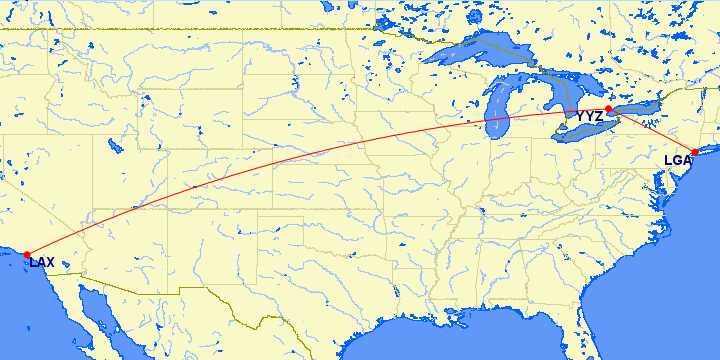With the increasing difficulty of using frequent flyer miles, it’s no surprise that many people are seeking to redeem on partner airlines instead. This sometimes creates situations that would rarely arise before, and one of those situations is called “cabotage.” Ever since another travel blogger, Jeff from Canadian Kilometers, lodged a cabotage-related complaint with the US Department of Transportation, it has made it a lot harder to book awards between US locations while transiting third countries.
What is cabotage? It is, quite simply, the practice of a foreign airline (or cruise line) carrying passengers between two points within the United States, even when transiting a third country. For example, consider a flight between Los Angeles and New York via Toronto. It seems like an awfully logical connecting point, just look at the map:
If you were to fly Air Canada from Los Angeles to Toronto, and then connect to another Air Canada flight from Toronto to New York, this would be cabotage because a foreign airline carried you the entire way between two US points. And Air Canada would be slapped with a huge fine. It’s $25,000 each time, so they have a strong incentive not to do this. Making matters worse, you might even be able to book this itinerary as an award flight if the airline you’re using has a badly programmed booking engine, causing you unexpected trouble at the airport.
This is what happened to Jeff, who booked a flight from Seattle to Guam on Eva Air, via Taiwan. He was (correctly) denied boarding because this would create a cabotage situation, torpedoing the risky hidden cities itinerary that he’d planned on the mistake fare he found. Rather than accepting that these things can happen when you play dangerous games, he filed a complaint with the DOT and created a situation where even entirely legitimate itineraries can now be difficult to book, and some itineraries are no longer possible to book at all with Avianca LifeMiles.
How do you avoid cabotage? It’s really easy: make sure that at least one part of an itinerary between US locations, which transits a third country, is on a US carrier. So, for example, it’s totally OK to book a flight from Los Angeles to Vancouver on Alaska Airlines, which then connects to a flight from Vancouver to New York on Cathay Pacific. This is not cabotage. In fact, I am doing this right now. Similarly, Jeff could have flown ANA to Tokyo, and switched to a United flight to Guam. You can even transit a city in a third country using a US carrier and this is also no problem. So, for example, if you want to fly from Seattle to Las Vegas via Vancouver BC on Alaska Airlines (which you might want to do if award inventory is only available with this itinerary), it’s entirely OK and there is no cabotage. You would have to pay both US and Canadian immigration and airport fees, though (and endure all the immigration hassles, and travel with your passport) so this is probably something you don’t actually want to do unless it’s truly necessary.
As long as you know the cabotage rules, you can probably manage to book itineraries that don’t actually involve it, but it might require booking over the phone and appealing to a supervisor in order to get it done. Plan extra time at the airport in case you’re challenged. And be aware that airline search engines are imperfect. They may recommend (and allow you to book) itineraries that involve cabotage and will result in you being denied boarding at the last minute. Conversely, they may not display itineraries that are perfectly valid and don’t involve any cabotage, but do transit through a third country. In this case, you may have to piece these itineraries together manually.
As always, the thrill is in the hunt when traveling on miles and points. Avoiding cabotage situations sounds difficult, but in reality, it’s really simple: always book at least one leg (either into or out of the US) on a US carrier.



2 thoughts on “Avoiding A Cabotage Calamity”